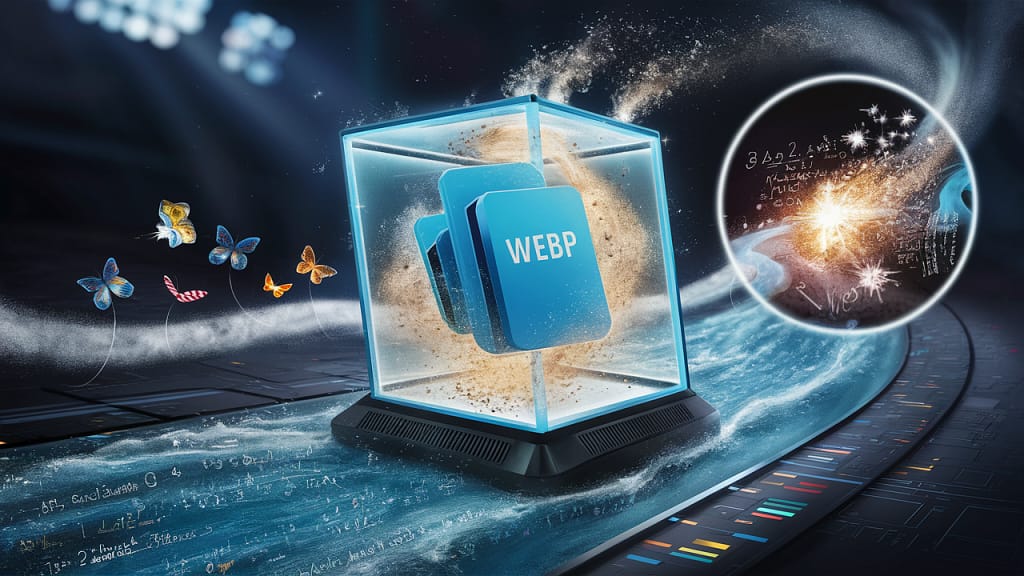Convert to WebP (Image Converter)
Convert to WebP is a free online tool that allows you to quickly and easily convert your images to WebP format. WebP is a modern image format that offers smaller file sizes and high visual quality, making your websites load faster. It provides a user-friendly experience with drag-and-drop support and batch conversion. Try it now and improve your website's performance!
Yakında: Download

Converting All Image Formats to WebP: A Comprehensive Guide
Convert to WebP makes converting your images to WebP format a breeze, while also standing out with the convenience it offers:
- Drag-and-Drop Simplicity: Simply drag and drop the images you want to convert directly into your browser. No complicated upload steps required!
- Batch Processing Power: Save time by converting multiple images to WebP at once. A great convenience, especially for website owners and content creators.
- Customizable Quality: Achieve the perfect balance between file size and visual quality by adjusting the conversion quality to your needs.
- Instant Results: The conversion process is completed quickly, and you can see the results instantly. This leaves you with more time to optimize your website's loading speed.
For example, if you're a blogger, you can shorten your page loading times and provide a smoother experience for your readers by converting your images to WebP format. Or, if you're an e-commerce site owner, you can make your site load faster and keep your potential customers engaged by converting your product images to WebP. Convert to WebP offers an easy and effective solution for everyone.
Advantages of WebP Format:
Smaller File Sizes, Faster Websites:
The most obvious advantage of WebP is that it offers much smaller file sizes compared to other popular formats (JPEG, PNG). This makes a noticeable difference in page loading times, especially for image-heavy websites. Users quickly get tired of slow-loading pages and are more likely to leave your site. With WebP, you can ensure that your visitors stay on your pages longer and interact more with your content.
Smaller file sizes also mean bandwidth savings. This is especially important for mobile users with limited data plans. With WebP, you can reduce the data consumption of your mobile users and provide them with a faster and smoother browsing experience.
Compression Without Sacrificing Visual Quality:
Another remarkable feature of WebP is its ability to compress images without significant loss of visual quality. This offers an ideal solution for those who want to create visually rich and fast-loading websites. WebP provides both lossy and lossless compression options, offering a solution for every need.
Lossy compression significantly reduces file size, while causing an acceptable amount of loss in visual quality. Lossless compression, on the other hand, preserves visual quality completely, while providing less reduction in file size. You can decide which option is more suitable for you based on the purpose of your images and the expectations of your target audience.
Widespread Support by Modern Web Browsers:
Although WebP was developed by Google, it is now supported by the vast majority of modern web browsers. This means you can deliver your WebP images seamlessly to all your users. For older browsers, you can provide fallback images in JPEG or PNG format alongside WebP images, ensuring that all your users can view your images without any problems.
WebP's browser support is constantly expanding. This shows the potential for WebP to become the dominant image format on the web in the future. By switching to WebP, you can prepare your website for the future and get ahead of your competitors.

Target Audience:
Convert to WebP for Website Owners:
Your website's speed is critical for user experience and search engine rankings. Slow-loading pages frustrate your visitors and increase your bounce rates. By optimizing your images with Convert to WebP, you can significantly improve your website's performance, ensuring that your users stay longer on your site and interact more with your content.
Convert to WebP for Bloggers:
Visual content helps make your blog more engaging and shareable. However, large images can slow down your page loading times. Convert to WebP allows you to optimize your images without sacrificing visual quality. This way, you can provide a blog experience that is both visually rich and fast loading.
Convert to WebP for Graphic Designers:
Visual quality is paramount for you. However, keeping file sizes under control is just as important. Convert to WebP allows you to significantly reduce your file sizes while maintaining your visual quality. This way, you can create designs that are both visually impressive and optimized for the web.
The Story of WebP: Google's Fast and Efficient Image Format
WebP is a modern image format developed by Google in 2010, aimed at speeding up the visual experience on the web. Offering smaller file sizes than traditional formats like JPEG, PNG, and GIF, while not compromising on visual quality, WebP enables websites to load faster and users to have a smoother browsing experience.
Google developed WebP to manage visual content on the web more efficiently and to allow users to access content faster. WebP being an open-source format has made it easier for developers and website owners to adopt this format and improve the overall performance of the web.
When WebP was first announced in 2010, it generated great excitement in the web community and presented a new opportunity to improve website performance. Since then, WebP has been continuously developed and is now supported by the vast majority of modern web browsers. The popularity of WebP is increasing, and it is seen as the future of visual content on the web.
Formats Convertible to WebP and Their Comparisons:
JPEG’den WebP’ye: JPEG, web’de en yaygın kullanılan resim formatlarından biridir, ancak dosya boyutları genellikle büyüktür. WebP, JPEG’e kıyasla aynı kalitede %25-34 daha küçük dosya boyutları sunar. Bu, web sitelerinin daha hızlı yüklenmesi ve daha az bant genişliği kullanması anlamına gelir. WebP, JPEG’in kayıplı sıkıştırma yöntemini kullanırken, daha gelişmiş algoritmalar sayesinde görsel kalitede belirgin bir kayıp yaşanmaz. Özellikle fotoğraflar ve karmaşık görseller için WebP, JPEG’e göre önemli avantajlar sunar.
PNG’den WebP’ye: PNG, özellikle şeffaf arka planlar gerektiren grafikler ve logolar için tercih edilen bir formattır. WebP, PNG’ye kıyasla hem kayıplı hem de kayıpsız sıkıştırma seçenekleri sunar. Kayıplı sıkıştırma ile PNG’den %26 daha küçük dosya boyutları elde edilebilirken, kayıpsız sıkıştırma ile PNG’ye benzer dosya boyutları elde edilir, ancak WebP’nin ek özellikleri (animasyon, şeffaflık) kullanılabilir. WebP, PNG’nin sunduğu şeffaflık ve renk derinliği gibi özellikleri desteklerken, daha küçük dosya boyutları sayesinde web sitelerinin performansını artırır.
GIF to WebP: GIF is an old format used for simple animations. WebP supports GIF's animation feature, while offering higher quality animations thanks to smaller file sizes and better compression algorithms. Unlike GIF's 256 color limit, WebP supports millions of colors, allowing for more vibrant and realistic animations. WebP stands out as a more modern and advanced format than GIF, further improving the animation experience on the web.
WebP: Google's Vision for Speeding Up the Web
WebP, introduced by Google in 2010, is a modern image format aimed at transforming the visual experience on the web. Compared to traditional formats like JPEG and PNG, WebP offers significantly smaller file sizes while maintaining the same visual quality. This allows websites to load faster, save bandwidth, and provide users with a smoother browsing experience.
WebP is part of Google's vision to make the web faster and more accessible. By combining lossy and lossless compression methods, WebP offers an ideal solution for both photos and graphics. Lossy compression significantly reduces file sizes, while lossless compression preserves visual quality completely. WebP also supports advanced features such as animation and transparency, making it a versatile format for visual content on the web.
Although developed by Google, WebP is an open-source format and is supported by the vast majority of modern web browsers. This means web developers and website owners can easily adopt WebP and improve the performance of their websites. The popularity of WebP is increasing, and it is seen as the future of visual content on the web. Google offers various tools and resources to encourage the adoption of WebP. WebP is an important technology that contributes to making the web faster, more efficient, and more accessible.
You can access Google's WebP page at the following link:
https://developers.google.com/speed/webp
Conclusion
Don't wait any longer to see the speed, quality, and efficiency advantages of WebP for yourself! Convert your images to WebP format effortlessly with Convert to WebP and instantly boost your website's performance. With drag-and-drop simplicity, batch conversion power, and customizable quality options, Convert to WebP offers an ideal solution for both professionals and amateurs.
Remember, your website's speed is critical for user experience and search engine rankings. By switching to WebP format, you can make your site load faster, encourage your users to stay on your site longer, and rank higher in search engines. Unleash the full potential of your website with Convert to WebP and get ahead of your competitors.
Try Convert to WebP now and see how it transforms your website's speed and performance! Discover the power of WebP and take your website to the next level. Remember, every second is valuable, and with Convert to WebP, you can make the most of every second.




